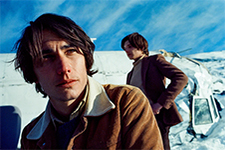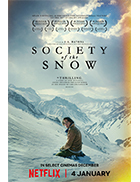Society of the Snow (La sociedad de la nieve)
|  It has been more than 50 years since a chartered airplane carrying 45 passengers and crew, most of whom were members of a Uruguayan rugby team and their families and friends, crashed in the Andes Mountains, leaving the survivors stranded for months in the wilderness where they were forced to turn to cannibalism in order to survive (of the 29 who lived through the crash itself, only 16 made it off the mountain). In those five decades, there have been numerous books written about the event, the most well-known of which is British novelist Piers Paul Read’s Alive: The Story of the Andes Survivors (1974), as well as a number penned by the survivors themselves (including Nando Parrado, Roberto Canessa, and Eduardo Strauch). The events have also inspired dozens of documentaries and television specials, a play, an opera, and two major feature films: Survive! (1976), a low-budget Mexican production based on Clay Blair’s 1973 book, and Frank Marshall’s Alive (1993), which is a generally good film outside of its casting of numerous white American actors in keys roles, including Ethan Hawke. And now we have J.A. Bayona’s Society of the Snow (La sociedad de la nieve), which is based on the 2009 book of the same title by Uruguayan journalist Pablo Vierci, who later co-authored survivor Roberto Canessa’s book I Had to Survive (Tenía que sobrevivir, 2016). The persistence in the popular imaginary of this event, which has been dubbed “The Miracle of the Andes,” is testament to our fascination with the extent to which people will push themselves in order to survive. As grisly as it is, given all the horrors and death and cannibalism, the story reassures us that the human will is indeed a mighty thing, and its impact on our desire to live can overcome the seemingly insurmountable. We may wince at the details and wonder “Could I do that?,” but such questions are always academic because we never really know until we are in that moment. I doubt that any of those rugby players ever wondered if they could eat human flesh to survive if they had to, and yet they all did, even those whose strong religious convictions made it particularly difficult to make the leap. Bayona’s interest in the story dates back to the research he was doing for an earlier film with a similar theme, The Impossible (2012), which told a fictionalized account of a family’s struggle to survive in the aftermath of the Indian Ocean tsunami in Thailand in 2004. The Impossible could just as easily have been the title for Society of the Snow, although Vierci’s title leans more heavily on the manner in which the survivors came together and formed a unique enclave on the inhospitable face of a glacier 13,000 feet in the mountains, 40 miles away from any other humans. The plane’s shattered fuselage, which broke away from the tail and wings when it hit the mountain due to pilot error and flew 5,000 feet down the glacier face like a bobsled, becomes their world for 72 days—a place of both protection from the bitter, freezing cold and a kind of chamber where they work out the realities of their survival, debating the ethics of eating the dead to ensure that they do not join them, questioning the role of God in their predicament, and straining to devise plans to escape the mountain once they learn (via a radio broadcast they are able to capture) that any rescue attempts have been called off after only a week. As the film unfolds, we get to know a number of the survivors in more and more detail. Some of them remain largely background figures, but a half dozen or so come to the fore, embodying different traits that define their unique society. Bayona was wise to cast virtually all unknown actors who bear striking physical resemblances to their real-life counterparts, as they have to embody the raw existence of ordinary people thrown into extraordinary circumstances (the presence of anyone resembling a star, like Ethan Hawke in Alive, would immediately puncture the carefully balanced reality Bayona is working so hard to construct). Enzo Vogrincic is particularly good as Numa Turcatti, the most religious and ethically committed survivor, the one who resists eating the longest because he simply cannot fathom how it could be morally justified. On the other end we have Nando Parrado (Agustín Pardella), who loses his sister and mother in the crash and becomes the most fiercely determined to save himself and others through sheer willpower (Pardella is perhaps a bit too model-handsome for the role, which telegraphs his alpha-male heroism). Bayona began his career under the mentorship of Guillermo del Toro, who executive produced his first feature, the moody horror thriller The Orphanage (El Orfanato, 2007). Since then, Bayona has had a wide and varied career, which has included the offbeat fantasy A Monster Calls (2014) and Jurassic World: Fallen Kingdom (2018), the umpteenth film in the resurrected-dinosaurs franchise. He has a gift for scale without losing character, and that is perhaps Society of the Snow’s greatest asset. At all times we are aware of the horrible grandeur of the Andes Mountains, the way their enormous, craggy peaks and deep crevasses create a seemingly impenetrable fortress—and possible tomb—around the survivors. Working with cinematographer Pedro Luque (Don’t Breathe), Bayona captures the simultaneous beauty and horror of nature via a deft mix of location shooting in the Sierra Nevada Mountains, a recreated crash site in an olive grove in Spain, and a set surrounded by giant screens. At times I could sense the difference between the actual location work and the set work, which might pull you out a bit as it did me. But, Bayona (who co-wrote the screenplay with Bernat Vilaplana, Jaime Marques-Olarreaga, and Nicolás Casariego) is ready to pull us right back in, whether it be in the claustrophobic horror sequence when the fuselage is suddenly buried by a rumbling avalanche or the powerful essence of the sheer will to live embodied by Nando and Robert Canessa (Matías Recalt), who eventually decide that the only way to live is to find a way out themselves. One could argue about whether or not this story needed to be told again, but the power of Bayona’s films suggests that it is a tale worth retelling. Copyright © 2024 James Kendrick Thoughts? E-mail James Kendrick All images copyright © Netflix |
Overall Rating: 

 (3)
(3)


